Forget traditional pasta—ricotta gnudi is here to change the game. Light, pillowy, and surprisingly easy to make, these Tuscan-style dumplings are essentially ravioli filling without the pasta shell.
The name “gnudi” means “nude” in Tuscan dialect, perfectly describing their minimalist charm. Paired with a fragrant sage butter sauce, this dish is a restaurant-quality meal you can whip up at home in just 30 minutes.
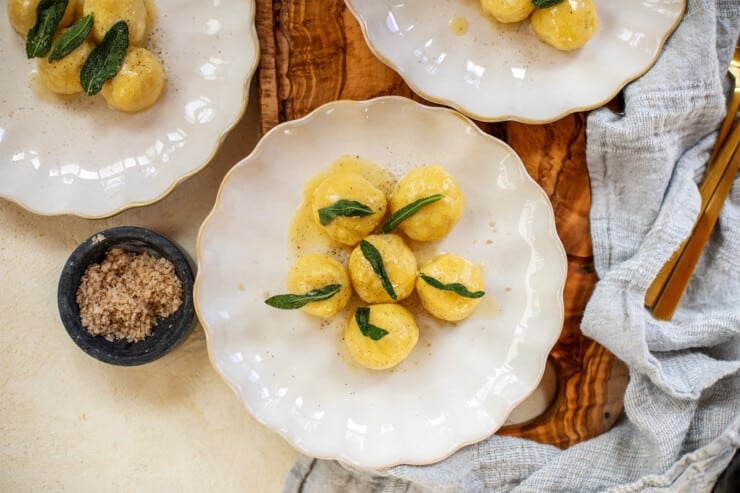
When I lived in Tuscany, I ate this dish whenever I got the chance. Florence can get cold and wet in the winter so a comforting meal is key. These days, when I’m arranging Italy trip planning for our clients, I insist they try this along with the many other famous Tuscan foods.

Why You’ll Like This Ricotta Gnudi Recipe
This ricotta gnudi recipe is bound to become a favorite, and here’s why:
- Simple Ingredients: With just a few pantry staples, you can create a dish that feels luxurious.
- Beginner-Friendly: Even if you’ve never made pasta, gnudi is foolproof and forgiving.
- Versatile: Pair it with a variety of sauces, herbs, or even grilled veggies.
- Quick to Make: Ready in about 30 minutes, it’s perfect for busy weeknights or dinner parties.
- Rich Yet Light: The ricotta keeps the gnudi soft and airy, while the butter sauce adds richness without heaviness.

Ingredients To Make This Recipe
Here’s what you’ll need to make ricotta gnudi with sage butter sauce:
- Ricotta Cheese: The star ingredient; use high-quality whole-milk ricotta for the best flavor and texture.
- Eggs and Parmesan Cheese: Bind the gnudi while adding richness and umami.
- Lemon Zest: Brightens the dish with a hint of citrus.
- Flour: Helps hold the gnudi together; gluten-free flour works too.
- Butter and Sage: Create a nutty, aromatic sauce that pairs beautifully with the gnudi.
- Salt and Pepper: Enhance all the flavors and add a finishing touch.



How To Make This Ricotta Gnudi Recipe
1. Prepare the Gnudi
In a bowl, mix ricotta, eggs, Parmesan, lemon zest, and salt. Gradually fold in flour until the dough is slightly sticky but manageable. Form gnudi into small balls using your hands or a cookie scoop. Dust generously with flour and chill for at least 5 minutes while you prepare the sauce.
2. Make the Sage Butter Sauce
Melt butter in a pan over medium heat until bubbling. Add sage leaves and toast for about a minute until crisp, then remove. Add a splash of boiling pasta water to the butter and simmer until slightly reduced. Gradually whisk in the remaining butter to create a silky sauce.
3. Cook the Gnudi
Boil a large pot of salted water. Drop the gnudi in and cook until they float to the surface, about 2-3 minutes. Remove with a slotted spoon and transfer directly to the sauce. Toss gently to coat.
4. Serve
Plate the gnudi, spooning extra sage butter sauce over the top. Garnish with fried sage leaves, flaky salt, black pepper, and a sprinkle of Parmesan. Serve immediately.

Variations On This Recipe
This ricotta gnudi recipe is versatile and customizable:
- Herbed Gnudi: Add chopped parsley, basil, or chives to the dough for an herbaceous twist.
- Tomato Sauce: Swap the butter sauce for a simple marinara or roasted tomato sauce.
- Truffle Butter: Elevate the dish by finishing it with a drizzle of truffle oil or truffle butter.
- Gluten-Free: Use a 1:1 gluten-free flour blend to make this dish gluten-free.
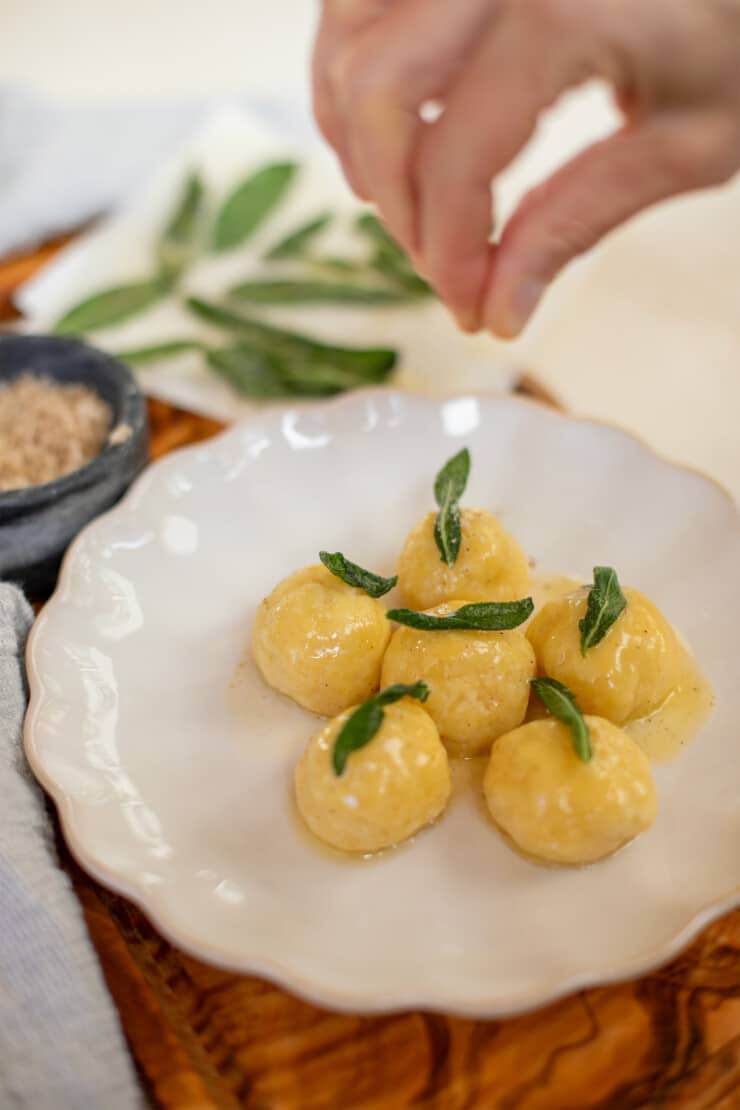
What’s the Difference Between Gnudi and Gnocchi?
While gnudi and gnocchi may seem similar, they’re quite different in texture and ingredients. Gnocchi, made with potatoes and flour (or chestnut flour), tend to be denser and heartier.
Gnudi, on the other hand, uses ricotta as its base, making it lighter, creamier, and almost cloud-like in texture. Think of gnudi as the delicate cousin of gnocchi—perfect for when you’re craving something decadent yet airy.
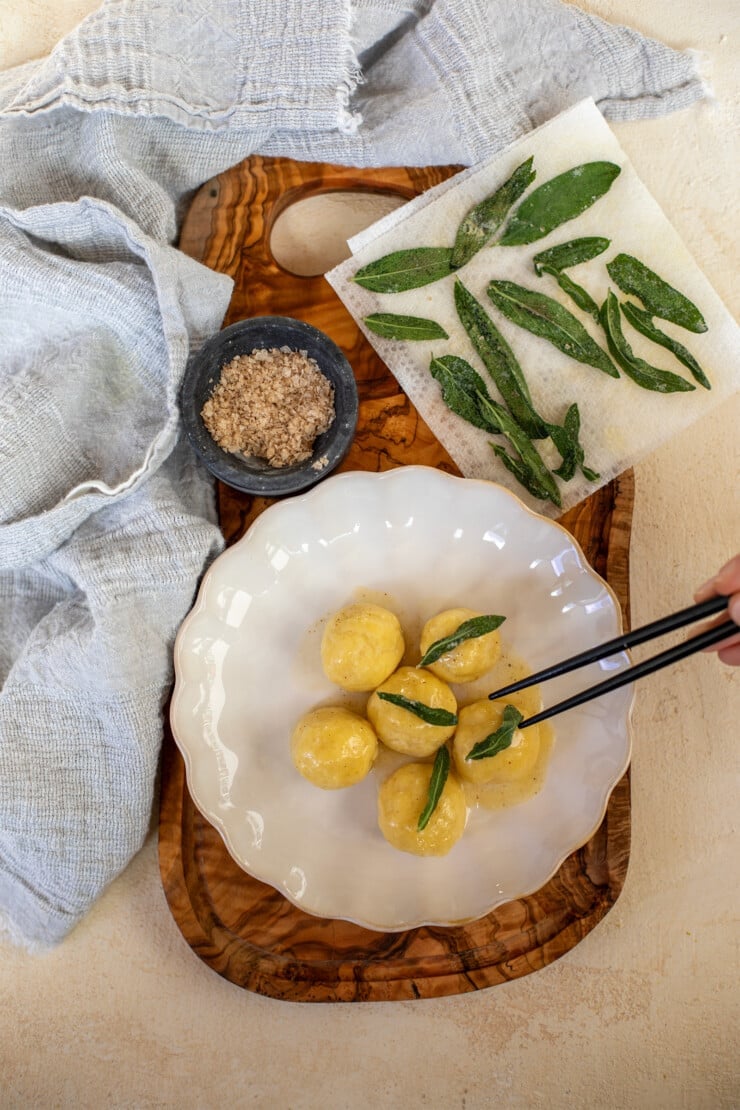
What is Beurre Monté Sauce?
The sage butter sauce in this recipe is a type of beurre monté, which translates to “mounted butter” in French. It’s an emulsified sauce made by slowly whisking butter into a small amount of liquid (in this case, pasta water).
The result is a glossy, silky sauce that clings beautifully to the gnudi without feeling heavy. Mastering beurre monté is a kitchen hack worth knowing, as it’s a versatile base for everything from vegetables to fish.
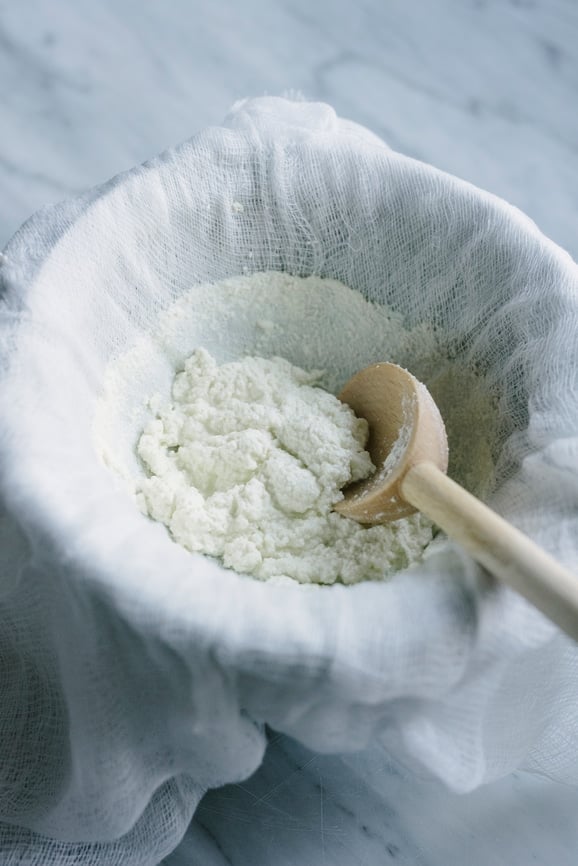
What Makes Good Ricotta Cheese?
Great ricotta is essential for gnudi. Look for fresh, whole-milk ricotta that’s creamy and slightly sweet, with a texture that’s almost fluffy (or make your own homemade ricotta!)
Brands like Bellwether Farms produce high-quality ricotta that’s perfect for this recipe. Steer clear of the rubbery, overly processed ricotta found in some grocery stores—it’s often watery and lacks the flavor and richness needed to make the gnudi shine. If you can’t find great ricotta, consider draining store-bought ricotta in a cheesecloth overnight to improve its texture.

Frequently Asked Questions About Ricotta Gnudi
Ricotta gnudi are Italian dumplings similar to gnocchi but made primarily from ricotta cheese and a little flour, making them lighter and fluffier. The basic ingredients for ricotta gnudi include:
- Ricotta Cheese: For the best results, use fresh, well-drained ricotta. If the ricotta is too wet, the gnudi may become too soft and fall apart during cooking.
- Flour: A small amount of flour helps to bind the ingredients. Some recipes use semolina flour, which can be substituted for all-purpose flour if desired.
- Egg: Acts as a binder to help keep the dumplings intact.
- Parmesan Cheese: Adds flavor and depth to the gnudi.
- Seasonings: Salt, pepper, and often a pinch of nutmeg or lemon zest to enhance the flavor.
Making ricotta gnudi involves a few simple steps:
- Mix Ingredients: Combine the ricotta, a beaten egg, grated Parmesan, salt, pepper, and a pinch of nutmeg. Gradually add flour to form a soft but manageable dough.
- Shape the Gnudi: Dust your hands with flour and gently form the mixture into small, round dumplings. Some cooks prefer to use two spoons to shape the gnudi into quenelles. Here we use a cookie scoop for fast work.
- Rest: Arrange the shaped gnudi on a floured tray and let them rest in the refrigerator for about 30 minutes to firm up.
- Cook: Boil a large pot of salted water and cook the gnudi in batches. They are done when they float to the surface, usually about 2-3 minutes.
- Serve: Serve hot with a sauce of your choice, typically a simple sage butter sauce or a light tomato sauce.
Ricotta gnudi are easy to make and the dough is pretty forgiving. But here are a few tips to make them the best ever:
- Drain the Ricotta: Ensure the ricotta is thoroughly drained of excess moisture to prevent the gnudi from becoming too soggy.
- Don’t Overmix: Mix the dough just enough to combine the ingredients. Overworking the dough can make the gnudi tough.
- Chill Before Cooking: Chilling helps the gnudi firm up and keeps them from falling apart when boiled.
- Use a Slotted Spoon: When cooking and removing the gnudi from the boiling water, use a slotted spoon to handle them gently to prevent breaking.
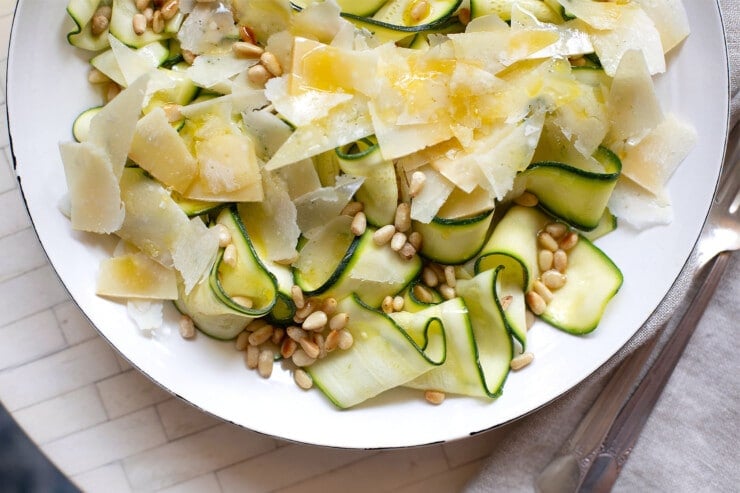
What To Serve This With
This ricotta gnudi pairs well with:
- Grilled Vegetables: Try zucchini, asparagus, or eggplant for a lighter side.
- Crisp Salads: A simple arugula salad with lemon vinaigrette or a simple green salad balances the richness of the dish.
- White Wine: Pair with a dry white wine like Pinot Grigio or Sauvignon Blanc.
- Crusty Bread: Use it to soak up any leftover butter sauce.
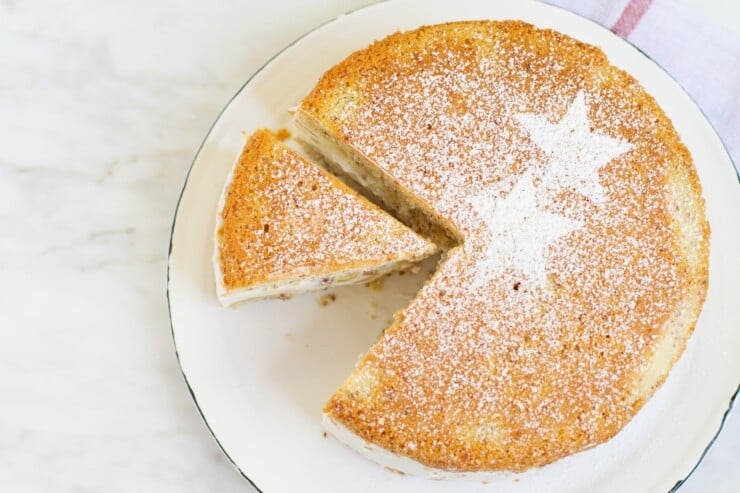
Additional Ricotta Recipes
Love this ricotta gnudi? Here are more ricotta recipes from Salt & Wind to try:

Tuscany Travel Guide
Are you considering traveling to Florence and the Tuscany region in real life? Check out our free Tuscany Travel Guide for our best travel tips, recipes, and articles on Italy.
Get A Personalized Travel Itinerary

Ricotta Gnudi With Butter Sage Sauce Recipe
Ingredients
For The Ricotta Gnudi:
- 1 pound whole milk ricotta cheese
- 1 large egg
- 1 large egg yolk
- 1 1/2 ounces Parmigiano Reggiano cheese finely shredded (about 2/3 cup)
- 1 lemon zested
- 1 teaspoon kosher salt
- 1 cup all-purpose flour
For The Butter Sage Sauce:
- 2 ounces cold unsalted butter (1 stick)
- 30 medium fresh sage leaves
- Freshly ground black pepper
- Maldon sea salt or other flaky sea salt, for garnish
Instructions
Make The Ricotta Gnudi:
- In a large bowl, combine the ricotta, the egg and egg yolk, the grated Parmigiano Reggiano, the salt, and lemon zest. Sprinkle the flour over the ricotta mixture and mix it in with a spatula. Once it is hard to mix with the spatula, use your hands and knead it briefly until it becomes a uniform ball. The mixture should be moist but not sticking to your hands when you touch it. Add in more flour (up to 1⁄2 cup more) as needed to make sure it sticks together but not to your hands.
- Now there are two ways you can form the ricotta gnudi. Either you do it by hand as follows: Dust the dough lightly with more flour and shape it into a ball. On a lightly floured work surface, roll the dough out to a rope and cut it into 32 to 36 pieces. Gently roll the pieces into balls and transfer them to a floured baking sheet.Or you can use a cookie scoop: Dust a rimmed baking sheet with all-purpose flour. Use a size #40 (1 1/2 tablespoons)cookie scoop to form golf ball-sized gnudi and gently release them onto the prepared baking sheet. Sprinkle the gnudi generously with more all-purpose flour.
- Place the gnudi in the refrigerator to chill while the water comes to a boil for at least 5 minutes(you could freeze them at this point for later). Bring a large pot of salted water to a boil. Meanwhile, make the sauce.
Make The Butter Sage Sauce:
- Melt half of the butter in a large pan over medium heat until it starts bubbling. Gently lay in the sage leaves and let them sizzle, toasting for about a minute until crisp and fragrant. Transfer the leaves to a paper towel-lined plate and sprinkle with a pinch of flaky salt.Next, ladle in 1/4 cup of boiling pasta water to the pan, stirring as it bubbles. Grind a generous amount of black pepper directly into the sauce to amp up the flavor.
- Take the pan off the heat, then slowly whisk in the remaining butter one piece at a time. Be patient—add each piece only after the previous one has fully melted into the sauce. Keep whisking until the sauce becomes shiny and silky, then stop. Don’t rush this step—it’s worth the extra effort!If you’re not serving the sauce immediately, keep it warm over a bain-marie (a hot water bath). Just make sure the sauce doesn’t touch the water, and avoid reheating it directly in the pan, as this can cause it to split.If your sauce does separate, don’t panic! Quickly remove it from the heat and grab a few pieces of ice-cold butter from the fridge. Whisk the cold butter into the sauce—it’ll lower the temperature and help bring everything back together.
Serve The Ricotta Gnudi:
- Add the gnudi to the sauce and turn to coat. Plate the gnudi in serving plates letting a little butter sauce pool around the bottom then top with a few fried sage leaves and a few pinches of salt and cranks of black pepper and serve immediately.